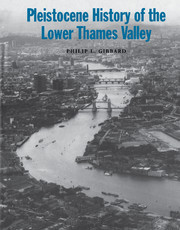Book contents
- Frontmatter
- Contents
- Preface
- 1 Introduction
- 2 Lithostratigraphy
- 3 Comparison of the pebble lithological composition of the gravel members
- 4 Sedimentary structures and depositional environments
- 5 Vertebrate faunal assemblages
- 6 Palaeobotany and biostratigraphy
- 7 Palaeolithic artefact assemblages
- 8 Palaeogeographical evolution of the Lower Thames Valley
- 9 Correlation with neighbouring areas
- References
- Appendix 1 Pebble counts from high-level gravels in the Epping Forest area
- Appendix 2 Pebble counts from the Lower Thames region
- Index
5 - Vertebrate faunal assemblages
Published online by Cambridge University Press: 04 August 2010
- Frontmatter
- Contents
- Preface
- 1 Introduction
- 2 Lithostratigraphy
- 3 Comparison of the pebble lithological composition of the gravel members
- 4 Sedimentary structures and depositional environments
- 5 Vertebrate faunal assemblages
- 6 Palaeobotany and biostratigraphy
- 7 Palaeolithic artefact assemblages
- 8 Palaeogeographical evolution of the Lower Thames Valley
- 9 Correlation with neighbouring areas
- References
- Appendix 1 Pebble counts from high-level gravels in the Epping Forest area
- Appendix 2 Pebble counts from the Lower Thames region
- Index
Summary
For over 150 years vertebrate remains have been recovered and collected from localities in the Lower Thames Valley. Many of these finds have been preserved in public or private collections, whilst others have long since been lost. Collections are normally dominated by large vertebrate material which was easily recognised during excavation, smaller remains having been often overlooked. By far the largest numbers of finds were made during the nineteenth century when digging was undertaken by hand. Since the advent of machine working, a severe decline in the frequency of finds has taken place.
Although the Lower Thames Valley contains some of the most productive vertebrate localities in the country, a complete synthesis has never been published. The most detailed study is that of Stuart (1976), but this concentrated on only five sites for which dating was relatively well established at the time. Stuart concluded that these five sequences each represented a part of a single temperate (interglacial) event (the Ipswichian Stage) and that changes in the faunal assemblage corresponded to similar changes recorded by the palaeobotanical evidence (Chapter 6). In contrast, Sutcliffe (1975, 1976, 1985) has repeatedly suggested that the climatic sequence of the Pleistocene was more complex than generally thought on the basis of the comparison of vertebrate assemblages from sites in the area.
- Type
- Chapter
- Information
- Pleistocene History of the Lower Thames Valley , pp. 131 - 139Publisher: Cambridge University PressPrint publication year: 1994



